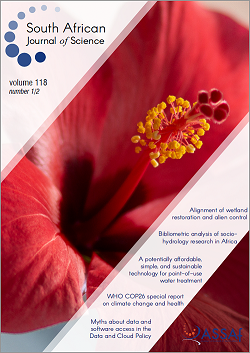Antiviral activity of chitosan nanoparticles for controlling plant-infecting viruses
DOI:
https://doi.org/10.17159/sajs.2022/10693Keywords:
chitosan nanoparticles, Bean yellow mosaic virus (BYMV), antivirus, faba bean, PR-1 gene regulationAbstract
Chitosan nanoparticles (ChiNPs) are a potentially effective means for controlling numerous plant diseases. This study firstly describes the antiviral capabilities of ChiNPs to control plant viral diseases compared to its bulk form. Bean yellow mosaic virus (BYMV) was used as a model plant virus affecting faba bean plants and many other legumes. The antiviral effectiveness of ChiNPs and chitosan were evaluated as a curative application method, using six dosage rates (50, 100, 200, 250, 300 and 400 mg/L). Results indicated that ChiNPs curatively applied 48 h post virus inoculation entirely inhibit the disease infectivity and viral accumulation content at 300 mg/L and 400 mg/L. The virus titre was greatly alleviated within the plant tissues by 7.71% up to100% depending on ChiNP dosage rates. However, chitosan used in its bulk-based material form revealed a relatively low to an intermediate reduction in virus infectivity by 6.67% up to 48.86%. Interestingly, ChiNPs affect the virus particle’s integrity by producing defective and incomplete BYMV viral particles, defeating their replication and accumulation content within the plant tissues. Simultaneously, ChiNP applications were appreciably shown to promote the pathogenesis-related (PR-1) gene and other defence-related factors. The mRNA of the PR-1 gene was markedly accumulated in treated plants, reaching its maximum at 400 mg/L with 16.22-fold relative expression change over the untreated control. Further, the total phenol dynamic curve was remarkably promoted for 30 days in response to ChiNP application, as compared to the untreated control. Our results provide the first report that chitosan-based nanomaterials have a superior effect in controlling plant viruses as an antiviral curing agent, suggesting that they may feasibly be involved in viral disease management strategies under field conditions without serious health concerns and environmental costs.
Significance:
- Our findings show that chitosan nanoparticles have a powerful curing antiviral activity against BYMV disease. These findings open the door for the use of eco-friendly nano-based tools in controlling numerous plant viruses. The use of eco-friendly nano-based materials could result in a successful integrative control strategy for plant viruses under field conditions, negating the need for the conventional measure used to control most of the insect-transmitted plant viruses, that is insecticide application against vector insects.
Published
Issue
Section
License

All articles are published under a Creative Commons Attribution 4.0 International Licence
Copyright is retained by the authors. Readers are welcome to reproduce, share and adapt the content without permission provided the source is attributed.
Disclaimer: The publisher and editors accept no responsibility for statements made by the authors
How to Cite
- Abstract 763
- PDF 1057
- EPUB 496
- XML 650













.png)